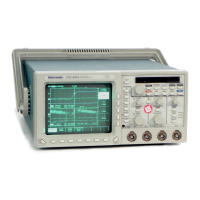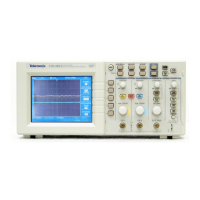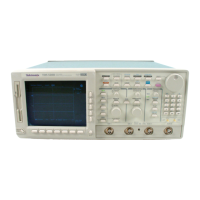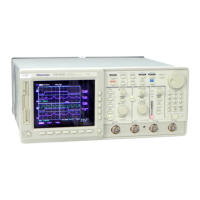Command Descriptions
TDS Family Oscilloscope Programmer Manual
2–237
TRIGger:MAIn:LOGIc:INPut:CH<x>
TDS 5XXA, 6XXA, & 7XXA Only
Sets or queries the main logic trigger input for the specified channel. The
channel is specified by <x> and is 1, 2, or 3. This is equivalent to setting the
inputs in the Logic Pattern Inputs side menu.
Trigger
TRIGger:MAIn:LOGIc:CLAss
TRIGger:MAIn:LOGIc:INPut:CH<x> { HIGH | LOW|X}
TRIGger:MAIn:LOGIc:INPut:CH<x>?
<Space>
?
HIGH
X
LOW
TRIGger :
:
LOGIc
MAIn
INPut :
:
CH <x>
HIGH specifies logic high.
LOW specifies logic low.
X specifies a do not care state.
TRIGGER:MAIN:LOGIC:INPUT:CH2 LOW
sets the main logic trigger input to logic low for channel 2.
TRIGger:MAIn:LOGIc:PATtern:INPut:CH4
TDS 5XXA, 6XXA, & 7XXA Only
Sets or queries the main logic trigger input for channel 4. These are the inputs
used when TRIGger:MAIn:LOGIc:CLAss is set to PATtern. This is equivalent to
setting the channel 4 input in the Logic Pattern Inputs side menu.
Trigger
TRIGger:MAIn:LOGIc:CLAss
Group
Related Commands
Syntax
Arguments
Examples
Group
Related Commands

